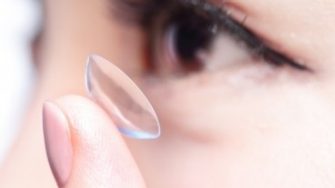
Contact lens discomfort is one of the main reasons for permanent discontinuation of contact lens wear. Contact lens discomfort probably occurs due to reduced compatibility between the contact lens and the ocular environment, especially the eyelids and tear film. This study was designed to determine the ability of clinical correlates related to eyelids and tear film to predict symptoms in contact lens wearers.
Eyelid signs and tear film characteristics of 30 habitual contact lens wearers were evaluated during a single visit. Study participants were classified into symptomatic (score >12) and asymptomatic (score ≤ 12) lens wearers based on the contact lens dry eye questionnaire - 8 (CLDEQ-8). Lid-wiper epitheliopathy, lid-parallel conjunctival folds, eyelid sensitivity and other eyelid margin signs such as ridging of Marx’s line, anterior blepharitis, hyperkeratinization, telangiectasia, lash loss, eyelid vascularity, irregularity or notching of eyelids, rounding of posterior margin, redness and thickness of lid margin and lash contamination were evaluated. Meibomian gland morphology and secretion, palpebral conjunctival health and tear parameters such as volume, meniscus height, thickness of lipid layer, osmolarity, break-up time and evaporation rate were also recorded. Statistical analysis of the data was performed using receiver operating curves and canonical discriminant function analysis, to derive predictive potential of each of the study variable in determining symptoms in lens wearers. The formula developed was: Symptom Discriminant Function Score = (3.378 x meibomian gland secretions grade) + (0.224 x meibomian gland morphology grade) + (0.61 x tear evaporation rate without contact lens) + (0.439 x lid parallel conjunctival folds grade) – (0.346 x palpebral conjunctival health grade) – 4.625.
Based on the evidence provided by this study, contact lens practitioners could monitor neophytes (new lens wearers) if they present with the predictors or develop these specific signs. Timely intervention before the signs worsen to an extent that these lens wearers develop to experience symptoms could avoid or reduce the rate of contact lens dropout.Validation of the developed equation is needed to confirm its accuracy with a new cohort of lens wearers. Early diagnosis of clinical markers of contact lens discomfort could help clinicians set realistic expectations for the wearer, and monitor and provide prophylactic management.
 For more information and to see our open access paper: Siddireddy JS, Tan J, Vijay AK, Willcox M. Predictive Potential of Eyelids and Tear Film in Determining Symptoms in Contact Lens Wearers. Optometry and Vision Science 2018;95:1035-45.
For more information and to see our open access paper: Siddireddy JS, Tan J, Vijay AK, Willcox M. Predictive Potential of Eyelids and Tear Film in Determining Symptoms in Contact Lens Wearers. Optometry and Vision Science 2018;95:1035-45.
